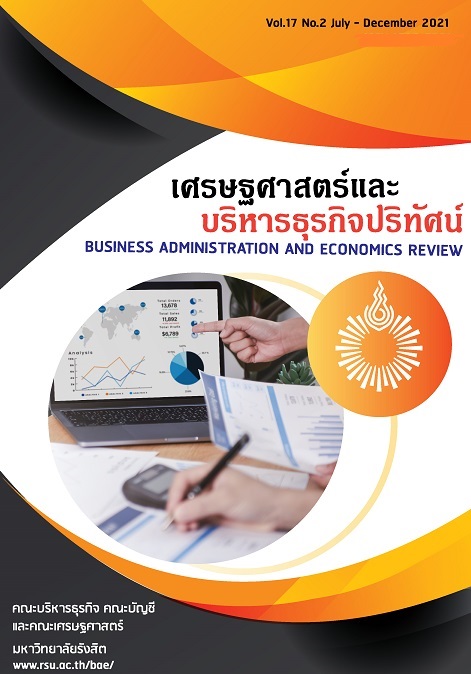The Influence of Business Potential on the Growth of Thai Listed Companies in The Market for Alternative Investment
Keywords:
Business potential, Growth rate, MAIAbstract
This research aims to study the relationship and impact of business potential on business growth by using the formula for calculating the growth rate recommended by the Capital Market Knowledge Promotion Center 2017, equal to the multiplication of retained earnings reserve and return on equity ratio. The business potential is divided into different areas. The capital structure is measured by the ratio of debt to equity ratio; financial liquidity is measured by the current ratio; and operational efficiency are measured by the return on assets, return on sales, net sales revenue. The data were collected from the financial statements for year 2015 – 2018 of 132 listed companies on the MAI, excluding companies in the financial business group by using multiple regression analysis methods for data analysis with the hypothesis test at a 95% confidence interval. The research results revealed that all three aspects of the business had potentially an impact the business growth by the debt to the equity ratio, current ratio, and net sales revenue, and adversely affecting the company's business growth, and return on assets has a relationship and positive effect on the company's growth rate at a significance level of 0.05. The control factor is considered the firm size, influencing the entity's growth rate.
References
Almansoura, B., Almansourb, Y., & Almansourc, A. (2019). Small and medium size enterprise: Access the financial and non-financial factors. Management Science Letters 9, 687–694.
Al-naif, K.L., & Shra'ah, A.E. (2018). Working capital management and profitability : Evidence from ordanian mining and extraction industry sector. Journal of Economics and Business Research, 27(1), 42-60.
Chinnasuk, R. (2010). An Analysis of the Capital Structure of Listed Company in the Property and Construction Sector in the Stock Exchange of Thailand. (Master’s thesis). Sukhothai Thammathirat Open University. Nonthaburi.
Capital Market Knowledge Promotion Center. (2017). Valuation and investment strategies in common stocks. Knowledge of general instrument products, (1st ed.), pp 75.
Danis, A., Rettl, D. A., & Whited, T. M. (2014). Refinancing, profitability, and capital structure. Journal of Financial Economics, 114(3), 424-443.
Delen, D., Kuzey, C., & Uyar, A. (2013). Measuring firm performance using financial ratios: A decision tree approach. Expert Systems with Applications, 40(10), 3970-3983.
Deros, B.M., Rahman, N., Zainal, N.H., Rahman, M.N.A. & Ismail, A.R. (2012). Development of an Effective Cost Management Method for Malaysian SMEs. AIJSTPME, 5(2), 27-32.
Fauver, L., & McDonald, M. B. (2015). Culture, agency costs, and governance: International evidence on capital structure. Pacific-Basin Finance Journal, 34, 1-23.
Gottardo, P., & Maria Moisello A. (2014). The capital structure choices of family firms. Managerial Finance, 40(3), 254-275.
Handoo, A., & Sharma, K. (2014). A study on determinants of capital structure in India. IIMB Management review, 26(3), 170-182.
Jitremet, S. (2016). Assessing Return and Risk in Market for Alternative Investment (MAI) using Fama-French Three-Factor Model. Bangkok University, Bangkok.
Kraus, Alan, & Robert H. L. (1973). A state-preference model of optimal financial leverage. Journal of finance, 28, 911-22.
Khunthongchan, S. (2009). Business growth of small and medium enterprises in a limited partnership that following sufficiency economy philosophy.. Journal Research of Khon Kaen University. (14)4, 271-283.
Mateev M., Poutziouris P., & Ivanov K. (2013). On the determinants of SME capital structure in central and eastern Europe: A dynamic panel analysis. Research in International Business and Finance, 27(1), 28-51.
Modigliani, F., & Miller, H. M. (1958). The cost of capital, corporation finance, and the theory of investment. American Economic Review, 48, 261-297.
Myers, S. C. (1977). Determinants of Corporate Borrowing. Journal of Financial Economics. 5, 147-76.
Margaretha, F., & Supartika, N. (2016). Factors Affecting Profitability of Small Medium
Enterprises (SMEs) Firm Listed in Indonesia Stock Exchange. Journal of Economics, Business and Management, 4(2), 132-137.
Maneerattanarungrot, C., & Donkwa, K. (2018). Causes and Effects of Financial Structure. WMS Journal of Management Walailak University. 7(3) 1 – 14.
Oino, I., & Ukaegbu, B. (2015). The impact of profitability on capital structure and speed of adjustment: An empirical examination of selected firms in Nigerian Stock Exchange. Research in International Business and Finance, 35, 111-121.
Phetkong, P. & Yupabhorn, B. (2019). The Relationship of Capital Structure on Firm Value and Profitabilityof Listed Companies in Market for Alternative Investment (MAI). Journal of Federation of Accounting Professions. 3(1) 62-82
Pattarabanjird, S. (2016). Financial liquidity Management for SMEs Entrepreneurs in World Economic Crisis. Journal of the College of Graduate Studies in Management. Khon Kaen University, 9(1) 281-303. Retrieved from https://so04.tci-thaijo.org/index.php/mbakkujournal/article/view/62502
Phongsuphat, A. (2013). Title of chapter. In Tile od book Business Finance (pp.363). Bangkok: Finance Department Faculty of Business Administration Kasetsart University.
Phriebchariyawat, A. (2008). Title of chapter. In Tile od book Financial Statement Analysis (pp 464-494). Bangkok: Company Amarin Printing and Publishing Public Company Limited.
Rafiq Ahmad. (2016). A Study of Relationship between Liquidity and Profitability of Standard Charterd Bank Pakistan: Analysis of Financial Statement Approach. Journal of Management and Business Research: C Finance,16 (1), 76-82.
Roszaini, H., & Mohammad, H. (2006). Corporate Governance Structure and Performance of Malaysian Listed Companies. Journal of Business Finance and Accounting, 33(6/7), 1034-1062.
Stefan, B., Wolfgang, D., Markus, S., & Heinz, Z. (2006). An Integrated Framework of Corporate Governance and Firm Valuation. Journal Citation Reports Ranking: 62(103), 249-283.
Wellalage, H. N., & Locke, S. (2015). Impact of ownership structure on capital structure of New Zealand unlisted firms. Journal of Small Business and Enterprise Development, 22(1), 127-142.
Zikmund, W. G., Babin, B. J., Carr, J. C., & Griffin, M. (2013). Business research methods (9th ed.). Singapore: Cengage learning.
Downloads
Published
How to Cite
Issue
Section
License
Copyright (c) 2021 Business Administration and Economics Review

This work is licensed under a Creative Commons Attribution-NonCommercial-NoDerivatives 4.0 International License.
The contents in Business Administration and Economics Review can be used for publication. But do not modify, modify or use it for trade and profit.

